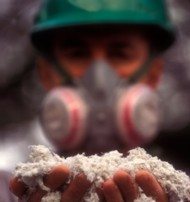Global Asbestos Ban Needed More Than Ever, Study Says

The authors of a new report on the “silent epidemic” of mesothelioma say a worldwide asbestos ban is more urgent now than ever.
The researchers are from universities in Australia, New Zealand and Pennsylvania. They are experts in medicine, public health, and pathology.
Their new report sums up the global problem of asbestos and its link to deadly illnesses like lung cancer, asbestosis, and malignant mesothelioma. Australia and New Zealand are among the countries that no longer allow any asbestos in or out but they still have many cases of mesothelioma.
The US has yet to institute an asbestos ban. Malignant mesothelioma affects about 2,500 Americans a year.
The Link Between Asbestos and Mesothelioma
Asbestos is the primary cause of malignant mesothelioma worldwide. Asbestos fibers are thin and sharp. When a person inadvertently inhales or swallows some of these microscopic fibers, they get stuck in the tissues. Over time, they can trigger cancerous changes in the DNA of the nearby cells.
Most people who get a mesothelioma diagnosis worked in an industry that used asbestos. Many did not have proper protection like special clothes and ventilators.
In the 55 countries with an asbestos ban in place, industries have been forced to find alternatives to asbestos. But many developing countries still use asbestos because it is so inexpensive. Public health experts believe the next big wave of mesothelioma cases will happen in these countries.
Why an Asbestos Ban is Needed
In their recent article in Expert Review of Anticancer Therapy, the authors write, “Asbestos, the most frequent cause of occupational cancer, continues to be consumed on a massive scale, with millions of people exposed on a daily basis.”
They say the lack of an asbestos ban everywhere is why the “silent epidemic” of mesothelioma and other asbestos cancers continues. They compare the spread of asbestos and asbestos-related diseases to the spread of smoking and lung cancer in the 20th century.
The epidemic of malignant mesothelioma is “silent” because many cases are never reported. This is especially true in developing countries and other places where there is no asbestos ban.
The authors say the misleading suggestion that some forms of asbestos are “safe” also contributes to the rise of mesothelioma. Their report details the “conclusion from bona fide research organizations that all forms of asbestos are carcinogenic.“
How to Stem the Tide of Malignant Mesothelioma
The report concludes that medical authorities can help reduce global mesothelioma cases, even in places where there is no asbestos ban.
“Experts in oncology, respiratory medicine, occupational and public health, and basic researchers must take responsibility and acknowledge the ongoing silent epidemic of asbestos-related diseases,” they write. “The call for a world-wide asbestos ban is more urgent than ever.”
Australia used to be the world’s biggest supplier of asbestos. Now they have one of the world’s strictest asbestos bans. No industry can use asbestos or any purpose and it cannot be imported or exported.
Because asbestos is so toxic, many Americans assume that the US has an asbestos ban. The EPA and OSHA do have rules in place for people who use or work around asbestos. But it is not banned.
Even after a country bans asbestos, it can take decades for the rate of mesothelioma to begin to decline.
Source:
Van Zanwijk, N, Reid, G & Frank, A, “Asbestos-related cancers: the ‘Hidden Killer’ remains a global threat”, march 29, 2020, Expert Review in Anticancer Therapy, Epub ahead of print, https://www.tandfonline.com/doi/full/10.1080/14737140.2020.1745067





